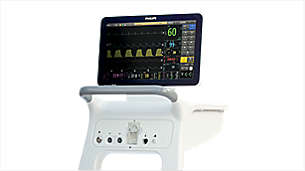Elevate Your MR Monitoring
In the challenging environment of MR patient monitoring, it is vital that patient data is easily and consistently available for caregivers across acuities while ensuring the security and integrity of this information.
Philips addresses these challenges with the MR Patient Care suite of solutions, which includes the Expression MR400 patient monitor and the MR Patient Care Portal 5000. Software Release 2.0 delivers enhancements that strengthen the capabilities and security of these products within your healthcare infrastructure, while also adding remote monitoring capabilities.

~40 million
MRI scans performed each year in the US1
MRI machines2,3 scanning patients throughout the United States.
About 1 of 5
ICU patients in the US require MRI scans*4 and these critical care unit patients, in turn, require an MR monitor. There is a need for solutions that can move continuously with the patient from critical care units to the MRI with accurate data to support anesthesiologists and other clinical staff.
*This number was collected in 2011
Features

Secure from the start
The Philips Expression MR400 is designed to help you protect patient privacy, prevent unauthorized access and maintain data integrity. The software upgrade brings further security enhancements, including encryption standard AES-256-GCM and gas standard 80601-2-55, plus user-defined password settings. It also provides software enhancements for security and greater useability, such as language updates and new monitor menus. The upgrade also makes the MR400 remote monitoring-ready* (PIC iX integration for Philips customers), allowing data to follow the patient from the bedside to the MR, and anywhere in between.
*Must have MR Patient Care Portal 5000 for connectivity for remote monitoring

Connect with confidence
Unlock the power of encryption, secure your hospital’s data, protect patient privacy and maintain regulatory compliance with the MR Patient Care Portal 5000. The software upgrade allows you to make the most out of the Philips MRPC solution, enabling wireless communication and time sync information between the Portal 5000 and the Expression MR400 patient monitor which allows for new remote monitoring workflows and seamless patient data flow.
Additionally, the MR Patient Care Portal 5000 takes security even further by being compliant with four encryption standards – HL7, AES-256-GCM, AES-256-CBC, and TLS 1.2 – as well as the 80601-2-55 gas standard.

Central monitoring from bedside to MR
The Philips MRPC software upgrade supports the continuity of data flow across acuities, for hospital-wide patient visibility and remote monitoring workflows allowing for a comprehensive view of your patient from anywhere in the hospital. For Philips customers, PIC iX integration facilitates increased patient visibility, complete documentation and a single patient overview display. Additionally, the upgrade may enable a smooth clinical workflow by reducing administrative complexity with the benefit of MR waveforms being sent directly to the EMR.
Featured products in MR Patient Care
Documentation
- Brochure
-
Footnotes
1. Shah A, Aran S. A Review of Magnetic Resonance (MR) Safety: The Essentials to Patient Safety. Cureus. 2023;15(10):e47345. doi:10.7759/cureus.47345
2. Census Bureau projects U.S. and World Populations on New Year’s day U.S. Department of Commerce. 2024.
www.commerce.gov/news/blog/2024/01/census-bureau-projects-us-and-world-populations-new-years-day.
3. Stewart C. MRI units density by country 2017. Statista. 2017.
www.statista.com/statistics/282401/density-of-magnetic-resonance-imaging-units-by-country/
4. Lee J, Geyer B, Naraghi L, et al. Advanced imaging use in intensive care units has decreased, resulting in lower charges without negative effects on patient outcome. Crit Care. 2015; 30(3): 460–464. doi:/10.1016/j.jcrc.2014.12.012


